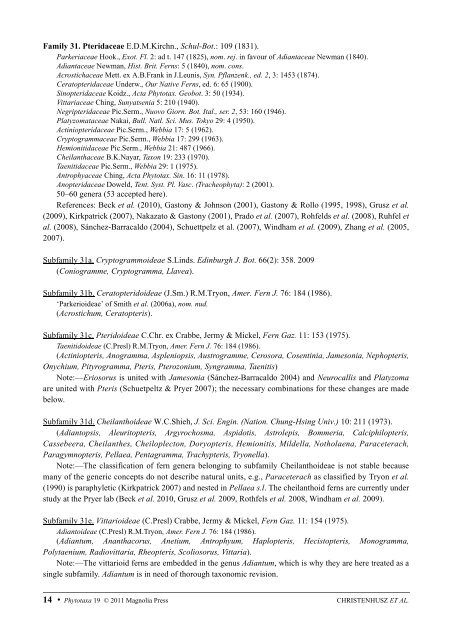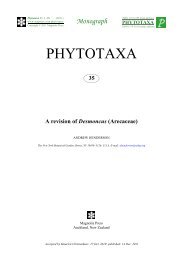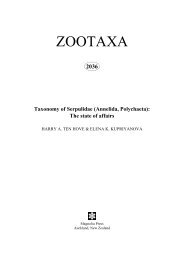A linear sequence of extant families and genera of ... - Magnolia Press
A linear sequence of extant families and genera of ... - Magnolia Press
A linear sequence of extant families and genera of ... - Magnolia Press
Create successful ePaper yourself
Turn your PDF publications into a flip-book with our unique Google optimized e-Paper software.
Family 31. Pteridaceae E.D.M.Kirchn., Schul-Bot.: 109 (1831).<br />
Parkeriaceae Hook., Exot. Fl. 2: ad t. 147 (1825), nom. rej. in favour <strong>of</strong> Adiantaceae Newman (1840).<br />
Adiantaceae Newman, Hist. Brit. Ferns: 5 (1840), nom. cons.<br />
Acrostichaceae Mett. ex A.B.Frank in J.Leunis, Syn. Pflanzenk., ed. 2, 3: 1453 (1874).<br />
Ceratopteridaceae Underw., Our Native Ferns, ed. 6: 65 (1900).<br />
Sinopteridaceae Koidz., Acta Phytotax. Geobot. 3: 50 (1934).<br />
Vittariaceae Ching, Sunyatsenia 5: 210 (1940).<br />
Negripteridaceae Pic.Serm., Nuovo Giorn. Bot. Ital., ser. 2, 53: 160 (1946).<br />
Platyzomataceae Nakai, Bull. Natl. Sci. Mus. Tokyo 29: 4 (1950).<br />
Actiniopteridaceae Pic.Serm., Webbia 17: 5 (1962).<br />
Cryptogrammaceae Pic.Serm., Webbia 17: 299 (1963).<br />
Hemionitidaceae Pic.Serm., Webbia 21: 487 (1966).<br />
Cheilanthaceae B.K.Nayar, Taxon 19: 233 (1970).<br />
Taenitidaceae Pic.Serm., Webbia 29: 1 (1975).<br />
Antrophyaceae Ching, Acta Phytotax. Sin. 16: 11 (1978).<br />
Anopteridaceae Doweld, Tent. Syst. Pl. Vasc. (Tracheophyta): 2 (2001).<br />
50–60 <strong>genera</strong> (53 accepted here).<br />
References: Beck et al. (2010), Gastony & Johnson (2001), Gastony & Rollo (1995, 1998), Grusz et al.<br />
(2009), Kirkpatrick (2007), Nakazato & Gastony (2001), Prado et al. (2007), Rohfelds et al. (2008), Ruhfel et<br />
al. (2008), Sánchez-Barracaldo (2004), Schuettpelz et al. (2007), Windham et al. (2009), Zhang et al. (2005,<br />
2007).<br />
Subfamily 31a. Cryptogrammoideae S.Linds. Edinburgh J. Bot. 66(2): 358. 2009<br />
(Coniogramme, Cryptogramma, Llavea).<br />
Subfamily 31b. Ceratopteridoideae (J.Sm.) R.M.Tryon, Amer. Fern J. 76: 184 (1986).<br />
‘Parkerioideae’ <strong>of</strong> Smith et al. (2006a), nom. nud.<br />
(Acrostichum, Ceratopteris).<br />
Subfamily 31c. Pteridoideae C.Chr. ex Crabbe, Jermy & Mickel, Fern Gaz. 11: 153 (1975).<br />
Taenitidoideae (C.Presl) R.M.Tryon, Amer. Fern J. 76: 184 (1986).<br />
(Actiniopteris, Anogramma, Aspleniopsis, Austrogramme, Cerosora, Cosentinia, Jamesonia, Nephopteris,<br />
Onychium, Pityrogramma, Pteris, Pterozonium, Syngramma, Taenitis)<br />
Note:—Eriosorus is united with Jamesonia (Sánchez-Barracaldo 2004) <strong>and</strong> Neurocallis <strong>and</strong> Platyzoma<br />
are united with Pteris (Schuetpeltz & Pryer 2007); the necessary combinations for these changes are made<br />
below.<br />
Subfamily 31d. Cheilanthoideae W.C.Shieh, J. Sci. Engin. (Nation. Chung-Hsing Univ.) 10: 211 (1973).<br />
(Adiantopsis, Aleuritopteris, Argyrochosma, Aspidotis, Astrolepis, Bommeria, Calciphilopteris,<br />
Cassebeera, Cheilanthes, Cheiloplecton, Doryopteris, Hemionitis, Mildella, Notholaena, Paraceterach,<br />
Paragymnopteris, Pellaea, Pentagramma, Trachypteris, Tryonella).<br />
Note:—The classification <strong>of</strong> fern <strong>genera</strong> belonging to subfamily Cheilanthoideae is not stable because<br />
many <strong>of</strong> the generic concepts do not describe natural units, e.g., Paraceterach as classified by Tryon et al.<br />
(1990) is paraphyletic (Kirkpatrick 2007) <strong>and</strong> nested in Pellaea s.l. The cheilanthoid ferns are currently under<br />
study at the Pryer lab (Beck et al. 2010, Grusz et al. 2009, Rothfels et al. 2008, Windham et al. 2009).<br />
Subfamily 31e. Vittarioideae (C.Presl) Crabbe, Jermy & Mickel, Fern Gaz. 11: 154 (1975).<br />
Adiantoideae (C.Presl) R.M.Tryon, Amer. Fern J. 76: 184 (1986).<br />
(Adiantum, Ananthacorus, Anetium, Antrophyum, Haplopteris, Hecistopteris, Monogramma,<br />
Polytaenium, Radiovittaria, Rheopteris, Scoliosorus, Vittaria).<br />
Note:—The vittarioid ferns are embedded in the genus Adiantum, which is why they are here treated as a<br />
single subfamily. Adiantum is in need <strong>of</strong> thorough taxonomic revision.<br />
14 • Phytotaxa 19 © 2011 <strong>Magnolia</strong> <strong>Press</strong><br />
CHRISTENHUSZ ET AL.
















